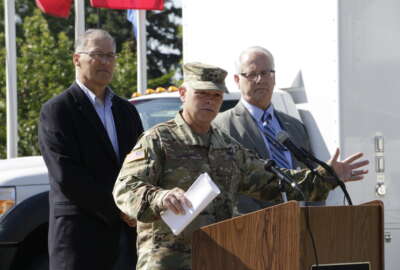The Defense Department’s top scientist is concerned about the state of defense businesses, critical infrastructure and security of microelectronics in the military, and he’s asking some of the Pentagon’s top minds to look into the issues.
In three Oct. 30 memos to the Defense Science Board — a group of military, civilian, science and academic experts sponsored by DoD — Defense Undersecretary for Research and Engineering Michael Griffin asked that task forces be set up to assess the businesses the Pentagon needs to create weapons and how to protect the military’s resiliency. He also asks a task force to look at how to ensure trustworthy microelectronics are used in military systems.
The 21st Century Industrial Base for National Defense Task Force is tasked with taking proactive steps to increase the depth, breadth and security of the defense industrial base.
The memo gives the task force up to 12 months to study how the industrial base can respond to the need for the military to surge and mobilize. It will also look at how industry can adapt modernization practices to continuously adapt to threats.
Griffin asked that the task force find out how industry can integrate supply chain development into product design; for example, using U.S.-made hardware instead of Chinese hardware.
He also wants to hear how business can mitigate cyber attacks, take advantage of what allied countries have to offer and how DoD can help businesses adapt their products for military use.
“The homeland — and the defense industrial base — is no longer a sanctuary and must be protected from adversary kinetic and non-kinetic attack even as the homeland operates in a global defense-industrial environment,” Griffin wrote in the memo.
Griffin wants the final report six months after the initial study period.
DoD’s concern about the industrial base stems from a shift in business compared to 50 years ago.
“Prime contractors were built around a group of approximately three dozen large conglomerate firms with substantial capacities in both advanced civil and military technologies and markets,” Griffin stated. “Microprocessors, high-performance jet engines, space systems and technology, advanced materials, etc., developed in the defense sector ‘trickled down’ into the civil sector.”
Today the technologies are taken from a global civilian scale and trickle down to the defense sector. The defense sector is continuing to shrink as the number of prime contractors declined from 30 to five between 1992 and 2007.
Griffin fears that defense companies are isolated on a national security “island” while operating a sea of commercial information-driven firms on a global basis.
Along those lines, Griffin also set up the Ensuring Microelectronics Superiority Task Force. DoD’s demand for innovative and trustworthy microelectronics is on the rise as they are used in more systems encompassing every domain — especially in areas the Pentagon is ramping up activity like artificial intelligence and quantum sciences.
That task force will look at ways DoD and industry can respond to the demand of microelectronics and how to access microelectronics producers that are true to the U.S. The task force will look into reducing the dependence on obsolete parts and ensuring the U.S. leads in high performance microelectronics for years to come.
The task force will consider what is needed in research, development and innovation for microelectronics and how public/private partnerships can be advanced for more secure microelectronics.
“The ability to meet many of the modernization priorities in the National Defense Strategy will rest on a secure microelectronics foundation: Both the technological capabilities, and a reformed acquisition and supply chain management process to ensure the delivery and verification of hardware and software that will be integrated into weapons systems,” Griffin wrote in the memo on microelectronics.
The final organization Griffin set up is the DoD Dependencies on Critical Infrastructure Task Force.
That body is meant to address a glaring gap in DoD’s security.
“DoD lacks a holistic, end-to-end understanding of — and limited ability to mitigate — the impact of degradation and failures in critical infrastructure on which force projection and functioning of defense critical assets depend,” Griffin wrote in the memo.
That shortcoming comes from the fact that a vast majority of critical infrastructure is owned by the private sector, and then supplies military installations.
There are issues with whom would be most important to restore utilities to first after an attack, and who would be in charge of restoring critical infrastructure.
Griffin asks the task force to identify the most serious threats and vulnerabilities, what the impacts would be to DoD if critical infrastructure was lost, and how well DoD is prepared to mitigate the consequences of outages.
Griffin also wants to know what steps DoD can take to improve resiliency, and how it can partner with other agencies to protect infrastructure.
The National Guard is already working on some of these vulnerabilities.
Washington Adjutant General Maj. Gen. Bret Daugherty said earlier this month that his state has been taking preemptive measures against cyber attacks for about a decade. Washington is another state with a deep tech talent pool to draw from.
“We use a ten-man team,” Daugherty said. “We do preventative work with owners and operators of critical infrastructure. They are partnered up right now with a power company that feeds one of our military bases. Our team has been monitoring that network and looking for vulnerabilities. They found them and are now in the process of developing a risk mitigation plan and helping the power company fix the vulnerabilities they found.”
The National Guard is also conducting a pilot program called the Cyber Mission Assurance Team. Their job is to assess vulnerabilities to infrastructure that supplies needs to federal assets.
Copyright
© 2024 Federal News Network. All rights reserved. This website is not intended for users located within the European Economic Area.

